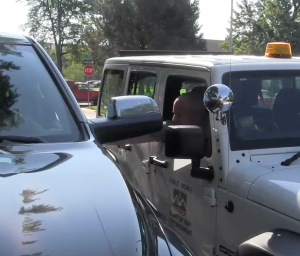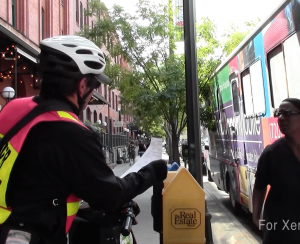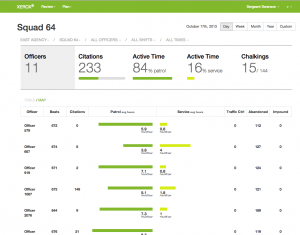 When edge cases become typical they signal transitions. Then we need new thinking for real understanding.
When edge cases become typical they signal transitions. Then we need new thinking for real understanding.
Edge cases are usually rare and far from the norm. They can challenge and inform how we think. They come up in answering even simple seeming questions on our project, which is developing analytics for traffic and parking enforcement organizations.
Beats and Shifts in Parking Enforcement
 Parking enforcement takes place in the context of managing urban transportation. Depending on the city, enforcement organizations can be in a Department of Transportation, a Department of Public Works, or a police department. Sometimes other departments in a city are involved in handling city garages or public parks.
Parking enforcement takes place in the context of managing urban transportation. Depending on the city, enforcement organizations can be in a Department of Transportation, a Department of Public Works, or a police department. Sometimes other departments in a city are involved in handling city garages or public parks.
 Enforcement organizations manage their activities in terms of shifts and beats. As in other jobs, shifts represent the hours that people work. Beats correspond to geographic areas in a city. The idea of “walking a beat” is traditional. Besides walking beats, there are also beats where officers use cars, carts, bicycles, Segways, and other kinds of vehicles.
Enforcement organizations manage their activities in terms of shifts and beats. As in other jobs, shifts represent the hours that people work. Beats correspond to geographic areas in a city. The idea of “walking a beat” is traditional. Besides walking beats, there are also beats where officers use cars, carts, bicycles, Segways, and other kinds of vehicles.
An officer is assigned a beat on his shift. Squads or teams of officers are managed by supervisors (sometimes called sergeants), and groups of sergeants report up to their managers (sometimes called captains). In one city we work with, officers are called “technicians.” Increasingly city departments are expected to be efficient. Data-driven enforcement is part of the movement to develop “smarter cities”.
Agility and Organizational Design
Consider a conversation between a supervisor and an officer, relayed to us during fieldwork (details changed).
Sergeant: It looks like you got a string of tickets in beat #14 yesterday. Officer Jones is complaining about poaching.
Officer Smith: Oh, right. I was returning from a traffic control assignment on Main Street. Did you want me to just drive by cars that were double-parked and cars parked in the bus zone (contrary to department policy)?
 This conversation took place in a city where enforcement officers fulfill many responsibilities. These include traffic control when there is an accident, a fire, or a power line down in a storm. Officers may also supervise traffic at schools during busy periods when parents are dropping off or are picking up kids. Such activities are broadly characterized as “service” activities and are part of the public safety mission of the departments.
This conversation took place in a city where enforcement officers fulfill many responsibilities. These include traffic control when there is an accident, a fire, or a power line down in a storm. Officers may also supervise traffic at schools during busy periods when parents are dropping off or are picking up kids. Such activities are broadly characterized as “service” activities and are part of the public safety mission of the departments.
In order to respond to service needs, enforcement organizations have dispatchers that can re-deploy nearby officers. When officers travel to and from service assignments, they sometimes pick up citations along the way. In the conversation above, Officer Jones complained that in working his beat he came across a block where the citations were already picked up — wasting his time and potentially hurting how his supervisor will see his performance.
[pullquote]In optimal foraging theory, hunters want others to stay out of their territories. They will collaborate only if there is an incentive.[/pullquote]The idea of “beats” reflects a way of thinking where a department divides a city into areas of a size that an officer can cover in a shift. Each officer is responsible for his own beat. This approach has several advantages. It is easy to describe. It spreads officers out so that they stay out of each other’s way. It does not require much ongoing communication. In analogy with optimal foraging theory, officers are analogous to hunters and beats correspond to hunting territories. Hunters want others to stay out of their territories. In foraging theory, hunters will collaborate if there is an adequate incentive, such as catching more game.
Beats were used to organize enforcement long before wireless communication systems were available. The deployment of Officer Smith to handle the traffic control responsibility departs from the simple beat approach because it interrupts his activity. Wireless communication enables organizations to respond more quickly to events and to assign officers dynamically where they are most needed. The example shows how organizations are evolving. Organizations now operate in a dynamic world, where communication enables information to flow quickly. Organizations are expected to respond and adapt. They now operate with multiple, competing goals in overlapping time frames.
Although working with agility is complex, embracing it ultimately leads to a deeper understanding and higher performance. A transition to agility can be supported by better analytics.
Edge Cases in Analytics
Edge cases require little when they are rare. In a study of citations for one of our clients, however, we found that over 60% of the citations issued on some beats were given by officers other than the one assigned. In that city, the interference between officer activities is no longer an edge case, but is becoming the norm. When that happens, thinking about how the organization works using just the traditional mindset of beats and shifts becomes an obstacle to operations and performance optimization. Consider the following question addressed in typical citation analytics:
“How many citations did Officer A issue on his shift?”
 The proper answer depends on the question’s purpose.
The proper answer depends on the question’s purpose.
Suppose a supervisor wants to review the performance of Officer A on his beat. She wants compare his performance to the previous performance of other officers on that beat during the same shift and day of the week in the same season. Should a citation count include tickets issued by the officer on other beats as he traveled to and from service assignments? If the day was typical and the service assignments were typical, the supervisor probably wants to consider his performance for the entire activity. Should tickets on the officer’s beat made by other officers traveling through be included? Probably not. On the other hand, if a manager wants to understand compliance on a beat, then tickets by anyone should be counted and off-beat tickets by the assigned officer should not.
Team Performance: Change Comes from the Edge
These two analytics options are just a beginning. Situations have nuances. How much time did the officer spend on his own beat versus others? Did the officer pass through other beats with much richer or poorer prospects for “hunting” citations? Did the officer pick up most of his citations at the end of the shift? We are developing spatial and temporal dashboards that can convey much richer stories about a “day in the life of an officer”, and also dashboards that convey explanations very simply. It is important to have multiple views of the data to illuminate what the constraints are, and our options in addressing them.
[pullquote]Recipe for coordination: better analytics, incentives, communication, and context awareness.[/pullquote] In analytics design, framing the right questions requires understanding organizational goals. When organizations adopt more agile approaches than traditional shifts and beats, they are trying not only to increase agility but also to optimize team performance. Increasing team performance requires increased coordination and collaboration. Increased coordination requires incentives, effective communication and context awareness for team members.
Thinking back to the example conversation where Officer Jones complained about Officer Smith “poaching,” a significant part of the issue was that Officer Jones did not know that the block was already covered. If Officer Jones’ mobile device kept him peripherally aware of Officer Smith’s activities, he need not have traveled to that block.
How else might a squad coordinate and collaborate? How could teamwork be more like players on a team sport passing a ball to set up scoring a goal?
Ideas about organizational culture and design questions are at the leading edge of thinking about optimizing team performance. Always under pressure to be efficient, enforcement organizations are also under pressure to be agile. They are often in transition to new ways of thinking. They need policies to set priorities and incentives, better analytics to help them understand and plan their policies and their dynamic activities, and ways to support coordination and collaboration.
(Thanks to Dan Bobrow, Eduardo Cardenas, David Cummins, Melissa Hart, and Ken Mihalov, and Farrukh Ali for comments on earlier versions).

